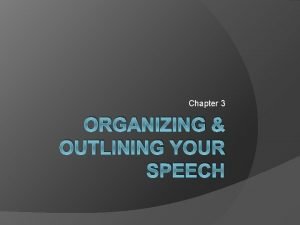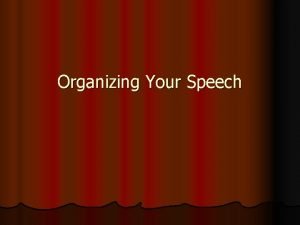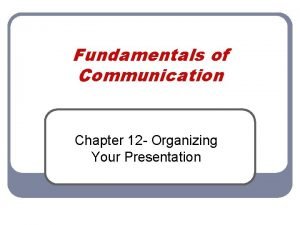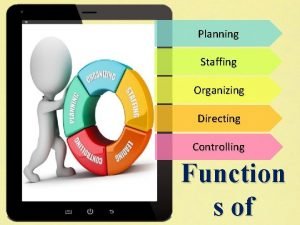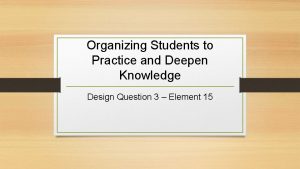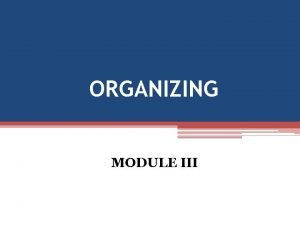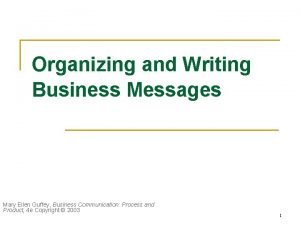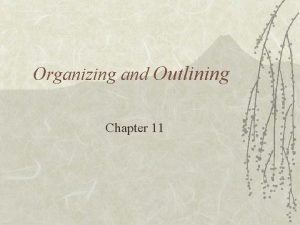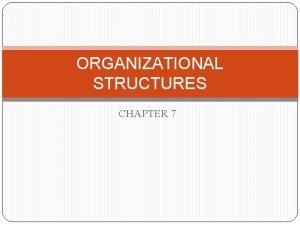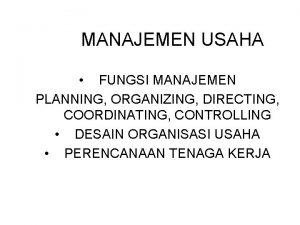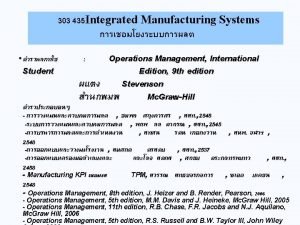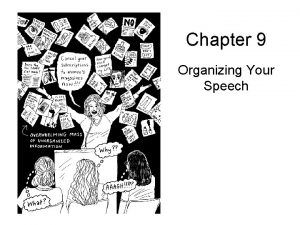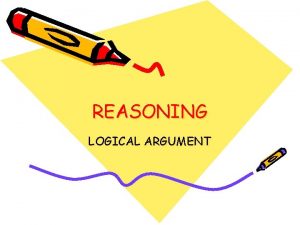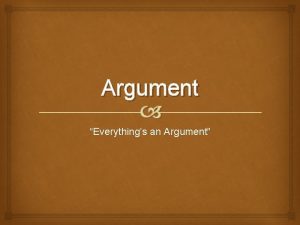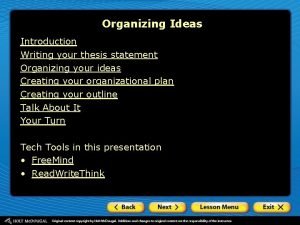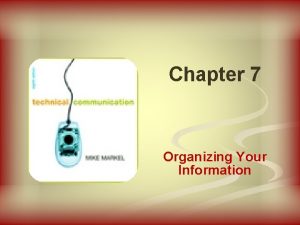Organizing Your Argument What is an argument An



















- Slides: 19

Organizing Your Argument

What is an argument? • An argument involves the process of establishing a claim and then proving it with the use of logical reasoning, examples, and research.

Organization • Why is organization important in building an argument? • Guides an audience through your reasoning process • Offers a clear explanation of each argued point • Demonstrates the credibility of the writer

Organization Organizing your argument ●Title ●Introduction -Thesis statement ●Body Paragraphs -Constructing Topic Sentences -Building Main Points -Countering the Opposition ●Conclusion

Title • Why do you need one? –Introduces the topic of the discussion to the audience –Generates reader interest in the argument

Creating a Title • Try to grab attention by - offering a provocative image - picking up on words or examples offered in the body or conclusion of the paper - asking a question • Avoid titles that are too general or lack character

Considering Titles • Imagine you just wrote a paper offering solutions to the problem of road rage. Which do you consider to be the best title? – Road Rage – Can’t Drive 55 – Road Rage: Curing Our Highway Epidemic

Introduction • What is an introduction? • Acquaints the reader with the topic and purpose of the paper • Generates the audience’s interest in the topic • Offers a plan for the ensuing argument

Methods for Constructing an Introduction • • • example – real or hypothetical question quotation shocking statistics striking image

What is a thesis statement? • The MOST IMPORTANT SENTENCE in your paper • Lets the reader know the main idea of the paper • Answers the question: “What am I trying to prove? ” • Not a factual statement, but a claim that has to be proven throughout the paper

Role of thesis statement • The thesis statement should guide your reader through your argument • The thesis statement is typically the last sentence in the introduction

Which thesis statement is the most effective for an argument bout the need for V-chips in television sets? • Parents, often too busy to watch television shows with their families, can monitor their children’s viewing habits with the aid of the Vchip. • To help parents monitor their children’s viewing habits, the V-chip should be a required feature for television sets sold in the U. S. • This paper will describe a V-chip and examine the uses of the V-chip in American-made television sets.

Body Paragraphs and Topic Sentences • Body paragraphs build upon the claims made in the introduction • Organize with the use of topic sentence that illustrate the main point of each paragraph. • Offering a brief explanation of the history or recent developments in your topic within the early body paragraphs can help the audience to become familiarized with your topic

Body Paragraphs • Paragraphs may be ordered in several ways, depending upon the topic and purpose of your argument: – General to specific information – Most important to least important point – Weakest claim to strongest claim

Offering a Counterargument • Addressing the claims of the opposition is an important component in the building of a convincing argument. • It demonstrates your credibility as a writer—you have researched multiple sides of the argument and have come to an informed decision

Offering a Counterargument • Counterarguments may be located at various locations within your body paragraphs. • You may choose to -build each of your main points as a contrast to oppositional claims -offer a counterargument after you have articulated your main claims

Counterarguing effectively • Consider your audience when you offer your counterargument • Conceding to some of your opposition’s concerns can demonstrate respect for their opinions • Remain tactful yet firm -Using rude or deprecating language can cause your audience to reject your position without carefully considering your claims.

Incorporating research into the body paragraphs • Researched material will aid you in proving the claims of your argument and disproving oppositional claims. • Be sure to use research to support the claims made in your topic sentences— make your research work to prove your argument

Conclusion—The Big Finale • Your conclusion should reemphasize the main points made in your paper. • You may choose to reiterate a call to action or speculate on the future of your topic • Avoid raising new claims in your conclusion
 Organizing an argument
Organizing an argument Organizing your argument
Organizing your argument Career portfolio examples
Career portfolio examples Organizing and outlining your speech
Organizing and outlining your speech Putting a speech together in a particular way
Putting a speech together in a particular way Amtobul persuasive speech examples
Amtobul persuasive speech examples Ontological vs teleological
Ontological vs teleological Give us your hungry your tired your poor
Give us your hungry your tired your poor Open your eyes the invisible argument
Open your eyes the invisible argument The ____ of your argument is faulty
The ____ of your argument is faulty Staffing directing and controlling
Staffing directing and controlling Organizing committee structure for an event
Organizing committee structure for an event Organizing for action strategy implementation
Organizing for action strategy implementation Planning directing controlling organizing
Planning directing controlling organizing Organizing students to practice and deepen knowledge
Organizing students to practice and deepen knowledge Work specialization
Work specialization Writing an academic paragraph
Writing an academic paragraph Organizing an outline
Organizing an outline Lattice organizational structure
Lattice organizational structure Fungsi manajemen coordinating
Fungsi manajemen coordinating



